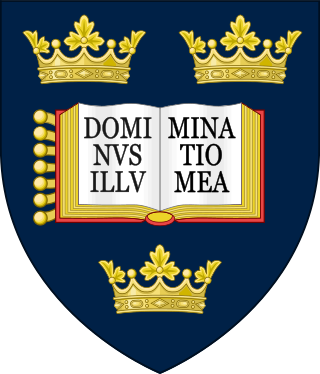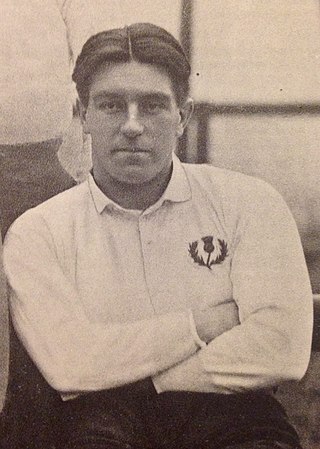
Cyril Nelson "Kit" Lowe, was an English rugby union footballer who held England's international try scoring record for over sixty years, a First World War flying ace credited with nine victories, and supposedly the inspiration for W. E. Johns' character "Biggles".

Major Stewart Walter Loudoun-Shand VC was a British recipient of the Victoria Cross (VC), the highest and most prestigious award for gallantry in the face of the enemy that can be awarded to British and Commonwealth forces. He was posthumously awarded the VC for his actions during an attack near the French village of Fricourt on the opening day of the Battle of the Somme.

The Varsity Match is an annual rugby union fixture played between the universities of Oxford and Cambridge in England. The event began in 1872 with the first men's match, with interruptions only for the two World Wars and the COVID-19 pandemic. Since 1921, the game has been played at Twickenham Stadium, London. It is normally played in early December.
The Old Alleynian Football Club is an open rugby union club founded as a team for the old boys of Dulwich College, themselves known as Old Alleynians. Founded in 1898, it is one of the oldest clubs in London and was the last of London's old boys clubs to become a fully open club. It is notable not only for its longevity, but also for the prominence it once attained on the club circuit and for the number of eminent players that have been members of the club, some of whom gained their international caps whilst at the club.

Ronald 'Ronnie' William Poulton was an English rugby union footballer, who captained England. He was killed in the First World War during the Second Battle of Ypres.

The Oxford University Rugby Football Club is the rugby union club of the University of Oxford. The club contests The Varsity Match every year against Cambridge University at Twickenham.

Lieutenant Cecil Halliday Abercrombie was a rugby union footballer, who represented Scotland and United Services RFC. He was also a first-class cricketer, playing for Hampshire.

William Purdon Geen was a rugby union wing and centre, who represented Wales, and played club rugby for Oxford University and Newport and county rugby for Monmouthshire. He was also invited to play for the Barbarians on several occasions. Geen unsuccessfully trialled for England in 1910, but was selected and played for Wales on three occasions in the 1912–1913 season. Injury prevented him from playing more internationals, and his service in the First World War put an end to his career.
William David Doherty, M.A., M.Ch., F.R.C.S., known as George Doherty was a medical superintendent of Guy's Hospital, London, and a former captain of the Ireland national rugby union team.

Air Marshal Sir David Grahame Donald,, often known as Sir Grahame Donald, was a Royal Naval Air Service pilot during the First World War, a senior Royal Air Force (RAF) officer between the wars and a senior RAF commander during the Second World War. In February 1939, Donald was appointed Director of Organisation at the Air Ministry. He was also a rugby union international having represented Scotland twice in 1914.

Ronald Owen Lagden was an English sportsman who played first-class cricket for Oxford University and represented England at rugby union.

William Ralph Martin-Leake was an English rugby union forward who played club rugby for Cambridge University and Harlequins and international rugby for England. In 1890 Leake became one of the original members of the Barbarians.

Charles Gurdon was an English barrister, judge, rower and rugby union forward who played club rugby for Cambridge University and Richmond. Gurdon represented England fourteen times during the early development of international rugby union, once as captain. He and his brother Edward Temple Gurdon formed one of the most notable sibling pairings in English rugby.
Rowland Fraser was a rugby union player, who played as a forward for Scotland, and also for Cambridge University RFC.

Walter Michael "Mike" Dickson was a rugby union player, who represented Scotland, Blackheath and Oxford. He was killed in World War I.

William "Willie" Middleton Wallace was a rugby union player. He played fullback for Cambridge University RFC and was capped for Scotland in 1913–14.

John Eric Greenwood was a rugby union international who represented England from 1912 to 1920. He also captained his country. During what would have been the prime of his playing career he fought in the First World War.

Arthur "Mud" James Dingle was a rugby union centre and wing, who won three caps for England, and played for County Durham, Hartlepool Rovers and Oxford University.

Francis Nathaniel Tarr was an English international rugby union player. He played centre for the Leicester Tigers and, between 1909 and 1913, won four caps for England, scoring two tries. He also earned three Blues while reading law at Oxford.
















